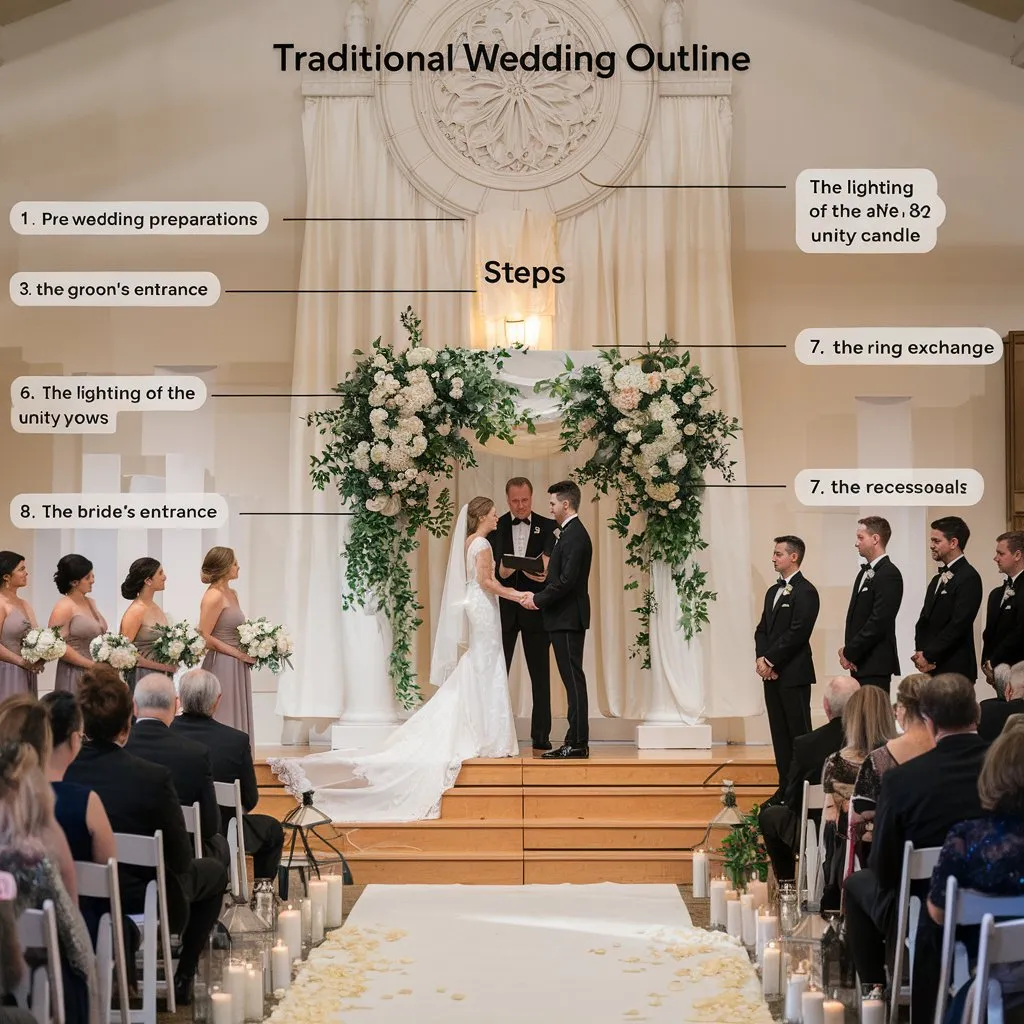Planning a wedding ceremony can be both exciting and stressful, but having a well-structured outline can help you and your loved ones enjoy the day without a hitch. In this guide, we'll walk you through the essential steps of a traditional wedding ceremony, provide variations for different cultural and religious practices, and give you some creative ideas for personalizing your special day.
A wedding ceremony is not just about the act of getting married; it’s a sacred and symbolic occasion that represents the union of two souls. While the reception may be full of fun and celebration, the ceremony itself is the heart of the event. A thoughtfully planned wedding ceremony outline is crucial to making sure that everything flows smoothly and reflects the values and personalities of the couple.
Why Every Couple Needs an Outline?
A wedding ceremony outline is essentially a guide that maps out the entire flow of the ceremony. It helps couples, officiants, and key participants understand the sequence of events, ensuring that everything happens in the right order and nothing gets left out.
Without a clear outline, it’s easy to overlook small but significant details. For example, you wouldn’t want the officiant to forget to pronounce you married or the ring bearer to miss their cue! A well-organized wedding ceremony outline also helps you avoid unnecessary stress on your wedding day by giving everyone a clear idea of what to expect. It’s a blueprint for a day that will be remembered for a lifetime.

Key Components of a Traditional Wedding Ceremony
Most wedding ceremonies, especially in Western cultures, follow a general structure. Below, we’ll dive deeper into the common elements of a traditional wedding ceremony outline.
The Processional
The processional is the grand entrance that kicks off the wedding ceremony. It’s a highly anticipated moment as the guests rise, and the music plays to welcome the wedding party.
Who Walks Down the Aisle First?
The processional order is important, as it sets the stage for the ceremony. Traditionally, the officiant enters first, followed by the groom and the groomsmen. Then come the bridesmaids, with the maid of honor last. The ring bearer and flower girl typically follow, and finally, the bride walks down the aisle, often accompanied by her father or a significant family member.
However, modern weddings allow for more flexibility. Some couples choose to have both parents walk them down the aisle, or they may walk together as a couple.
Symbolism Behind the Processional
The processional symbolizes the transition from single life to marriage. Each person walking down the aisle has a specific role, whether it’s to support the couple or to celebrate the joining of two families.
Opening Remarks by the Officiant
Once everyone is in place, the officiant begins the ceremony with a few words of welcome and reflection. The opening remarks set the tone, whether formal, religious, or light-hearted.
Example of Traditional Opening Remarks
An officiant might begin with something like:
“Dearly beloved, we are gathered here today to celebrate the love and union of [Name] and [Name]. Today marks the beginning of a new chapter in their lives, and we are honored to share this moment with them.”
If the couple desires a more personal touch, the officiant may tell the couple’s story, how they met, or the values that brought them together.
Exchange of Vows
The vows are arguably the most emotional part of the wedding ceremony. This is where the couple makes their promises to each other in front of their guests, family, and friends.
Traditional Vows
Traditional vows are often deeply rooted in religious or cultural traditions. A typical example of traditional vows might sound like:
“I, [Name], take you, [Name], to be my lawfully wedded [husband/wife], to have and to hold, from this day forward, for better or for worse, for richer or for poorer, in sickness and in health, to love and to cherish, until death do us part.”
These vows symbolize the depth of commitment and the unconditional love that will guide the couple through life's journey together.
Personalized Vows
For couples who prefer a more modern touch, writing personalized vows offers a chance to express their individual feelings and promises. These vows can be as intimate, humorous, or poetic as the couple desires, often incorporating inside jokes, shared memories, and future hopes.
For example:
“[Name], from the moment we met, I knew you were my person. I promise to laugh with you in moments of joy, comfort you in times of sorrow, and always cheer for you—even when you’re watching our favorite show without me.”
Personalized vows allow couples to bring their unique personalities and love story into the ceremony, making it all the more special.
Ring Exchange
The exchange of rings is one of the most iconic moments in any wedding ceremony. It signifies an unbroken circle of love, commitment, and eternity.
Meaning of the Ring Exchange
The symbolism behind the ring exchange is profound. The circular shape of the ring represents infinity—there is no beginning or end—just like the eternal love between the couple. By giving and receiving these rings, the couple acknowledges their intention to stay connected, no matter the challenges ahead.
Religious Variations on the Ring Exchange
In Christian weddings, the officiant may bless the rings before the couple exchanges them. In Jewish ceremonies, the ring is typically placed on the bride's right index finger, which is believed to have a direct line to the heart. Hindu weddings, on the other hand, may include an exchange of flower garlands in addition to the rings.
The Pronouncement of Marriage
Once the vows and rings have been exchanged, the moment everyone is waiting for arrives—the officiant declares the couple married!
Christian Pronouncement
In a Christian ceremony, this moment often comes with the phrase:
“I now pronounce you husband and wife. You may kiss the bride.”
Secular Pronouncement
For non-religious ceremonies, the pronouncement might sound something like:
“I now pronounce you partners for life. You may kiss!”
This pronouncement signals the official start of the couple’s married life together, often followed by a joyous round of applause and cheers from the guests.
The Recessional
This is the closing act of the ceremony, as the newlyweds walk back down the aisle as a married couple. The recessional is often accompanied by upbeat, celebratory music, marking the beginning of the festivities. It's a moment filled with joy as guests shower the couple with confetti, rice, or rose petals, symbolizing good luck and blessings for their future.

Variations in Religious Wedding Ceremonies
While the traditional ceremony structure is common, different religions and cultures have their own unique rituals that bring added meaning to the wedding ceremony. Let’s explore some of these variations.
Christian Wedding Ceremony Outline
A Christian wedding typically includes religious readings, prayers, and hymns. Some Christian ceremonies may also involve communion or the lighting of a unity candle to symbolize the joining of two families.
Jewish Wedding Ceremony Outline
A Jewish wedding is rich in traditions. It often includes the signing of the Ketubah (marriage contract), the Seven Blessings (Sheva Brachot), and the breaking of the glass, symbolizing the fragility of human relationships and the importance of nurturing love.
Hindu Wedding Ceremony Outline
A Hindu wedding is a vibrant and elaborate celebration that can last several days. Key elements include the Saptapadi, where the couple takes seven steps around a sacred fire, each step representing a vow they make to each other.
Sample Vows and Readings
Whether you opt for traditional or modern vows, adding readings to your ceremony can make the event even more memorable.
Traditional Vows Examples
Here’s another example of traditional vows that could be used in Christian or non-religious ceremonies:
“I give you this ring as a symbol of my love. I promise to be with you always, in joy and in sorrow, in plenty and in want, in sickness and in health. I will love and honor you all the days of my life.”
Religious Readings for Weddings
Popular religious readings include:
- Corinthians 13:4-7: "Love is patient, love is kind. It does not envy, it does not boast, it is not proud..."
- Ruth 1:16-17: "Where you go, I will go, and where you stay, I will stay..."
These readings emphasize love, commitment, and the bond of marriage, making them perfect for traditional ceremonies.
In the end, a wedding ceremony outline is your roadmap to a beautiful, seamless celebration. It ensures that all the key moments—big and small—are thoughtfully planned and executed. Whether you're going the traditional route or creating something uniquely your own, a well-structured outline will bring peace of mind on your special day, allowing you to focus on what truly matters: your love for each other.
FAQs
-
What is the best way to personalize a wedding ceremony outline? Personalizing your ceremony can be done through custom vows, adding meaningful readings, or including symbolic rituals that reflect your values and relationship.
-
Do we need to follow a traditional wedding ceremony structure? Not at all! Many couples choose to blend traditional and modern elements or even create their own structure. The most important thing is that it feels right for you.
-
How can we incorporate both of our cultures into the ceremony? Incorporating traditions from both cultures can be done through rituals, attire, or special readings. Work with your officiant to blend these elements seamlessly into your ceremony.
-
How long should a typical wedding ceremony be? A standard wedding ceremony lasts about 20 to 30 minutes, though it can vary depending on the rituals, readings, and vows.
-
Can we write our own wedding ceremony script? Absolutely! Writing your own script is a wonderful way to add a personal touch and make your ceremony truly unique.

 Vietnamese
Vietnamese









Nguyen Hoai Thanh
Nguyen Hoai Thanh is the Founder and CEO of Metaconex. With 12 years of experience in developing websites, applications and digital media, Nguyen Hoai Thanh has many stories and experiences of success to share.